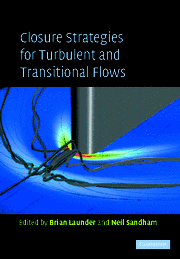8 - Introduction to Large Eddy Simulation of Turbulent Flows
Published online by Cambridge University Press: 06 July 2010
Summary
Introduction
This chapter is meant as an introduction to Large-Eddy Simulation (LES) for readers not familiar with it. It therefore presents some classical material in a concise way and supplements it with pointers to recent trends and literature. For the same reason we shall focus on issues of methodology rather than applications. The latter are covered elsewhere in this volume. Furthermore, LES is closely related to direct numerical simulation (DNS) which is also widely discussed in this volume. Hence,w e concentrate as much as possible on those features which are particular to LES and which distinguish it from other computational methods.
For the present text we have assembled material from research papers,earlier introductions and reviews (Ferziger 1996,Härtel 1996,Piomelli 1998),and our own results. The selection and presentation is of course biased by the authors’ own point of view. Supplementary material is available in the cited references.
Resolution requirements of DNS
The principal difficulty of computing and modelling turbulent flows resides in the dominance of nonlinear effects and the continuous and wide spectrum of observed scales. Without going into details (the reader might consult classical text books such as Tennekes and Lumley (1972)) we just recall here that the ratio of the size of the largest turbulent eddies in a flow, L,to that of the smallest ones determined by viscosity, η, behaves like L/η ∼ Re3/4u′. Here, Reu′= u′ L/ν with u′ being a characteristic velocity fluctuation and ν the kinematic viscosity. Let us consider as an example a plane channel,a prototype of an internal flow. Reynolds (1989) estimated Re′ ∼ Re0.9 from u′ ∼ u c1/2f, cf ∼ Re−0.2, where Re is based on the center line velocity and the channel height. In a DNS no turbulence model is applied so that motions of all size have to be resolved numerically by a grid which is sufficiently fine. Hence, the computational requirements increase rapidly with Re. According to this estimate a DNS of channel flow at Re = 106 for example would take around hundred years on a computer running at several GFLOPS. This is obviously not feasible. Moreover,in an expensive DNS a huge amount of information would be generated which is mostly not required by the practical user. He or she would mostly be content with knowing the average flow and some lower moments to a precision of a few percent.
- Type
- Chapter
- Information
- Closure Strategies for Turbulent and Transitional Flows , pp. 267 - 298Publisher: Cambridge University PressPrint publication year: 2002
- 28
- Cited by

